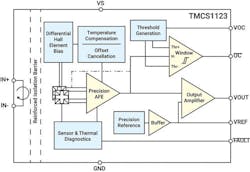Members can download this article in PDF format.
Over the past decade, engineers have increased the capability of sensors and actuators to enable advanced driver-assistance system (ADAS) features such as automatic braking systems, collision warning, and traction and stability control. These features are now standard equipment in many new cars and trucks.
Going forward, high-voltage systems—e.g., electric vehicles (EVs) and distributed solar-energy applications—are also being equipped with devices able to sense their environment quickly and reliably, playing a crucial role in helping accelerate the adoption of renewable-energy sources. The latest sensors can work directly on high-voltage circuits, enabling designers to place them closer to heat sources and obtain accurate readings faster.
Sponsored Resources
- How Accurate Sensing Enables Better System Performance and Increased Efficiency
- Simplifying High-Voltage Sensing with Hall-Effect Current Sensors
- How Precision ADCs Enable Highly Accurate Metering Systems in EV Chargers
Sensor ICs are typically designed for a specific type of sensing, whether it’s measuring current, voltage, humidity, proximity, etc. Recent sensor IC technology innovations have focused on integrating more capabilities into the IC while also increasing overall accuracy and reliability. These innovations have led to better system performance and greater energy efficiency.
Sensor Importance Ramped Up by Three Key Factors
Generally speaking, sensors have moved up in the priority list because of three distinct drivers.
First, sensing and monitoring technologies for high-voltage systems help engineers accurately measure voltage to improve safety and reliability. Thus, designers can reduce costs by lowering design margins. Showing users exactly how much charge is left in a battery, for example, translates into better performance, less range anxiety, and an overall improved consumer experience.
With EVs, a key challenge is how to maximize the efficiency and capacity of each battery cell. To do so, it’s critical to efficiently track what you’re putting in and getting out.
As EVs communicate with their chargers, the charger needs to report the amount of charge that’s available and how much charge is needed in the coming hours. The essential element is to have precise and intelligent monitoring of charge levels, the rate of charge, and the battery’s temperature. The more accurately you can measure these factors, the more capacity you can safely get out of the battery.
Second, for electrification to deliver the full benefits of greater efficiency and more responsible resource usage, high-voltage devices must operate at peak efficiency while generating, converting, delivering, and storing energy. Energy efficiency is an essential tool for policy makers committing to lofty climate goals.
Innovations in high-voltage technologies are enabling design engineers to develop more efficient solutions that make electrification and renewable-energy technology more accessible. Advanced technologies include gallium-nitride (GaN) FETs, which help convert DC power coming out of a solar panel into AC power. Such FETs also make possible the design of micro-inverters that are small and inexpensive enough to be mounted directly on or near the panels themselves.
Wide-bandgap materials, which also include silicon carbide (SiC), enable efficient power conversion, reduce power losses, and increase efficiency in high-voltage systems. For example, TI’s isolated gate drivers can be paired with SiC switches in EV onboard chargers and traction inverters to increase efficiency and reduce weight, size, and energy waste in the drive system.
Third, accurate and easy-to-use sensors that can run directly on high-voltage circuits, such as TI’s TMCS1123 Hall-effect current sensor, are important to high-voltage systems because they provide accurate readings faster. This helps solar-panel or EV designers accelerate the innovations that produce, transfer, store, and consume energy more efficiently.
Sensors that Deliver High Accuracy
Hall-effect and shunt-based current sensors are among the most common technologies requiring current sensing. In EV charging and solar-inverter systems, current sensors measure current flow by monitoring the voltage drop across a shunt resistor.
Shunt-based current sensors are generally more accurate than Hall-effect current sensors across the entire current range. Using stable amplifier technologies or precision analog-to-digital converters (ADCs) and precision shunt resistors, engineers can achieve high accuracy with less than 1% drift over the entire current measurement range, temperature, and lifetime.
However, to date, using Hall-effect sensors in high-voltage applications has been problematic. Typically, tradeoffs are made when using shunt-based vs. Hall-effect solutions.
Nonetheless, new levels of system efficiency can be reached with parts such as TI’s TMCS1123, which features ultra-low propagation delay (600 ns) and low sensitivity lifetime drift (±0.5%) (Fig. 1). With this current-sensing device, you can accurately sense current in high-voltage applications like EV chargers, while limiting design complexity and tackling design problems quickly.
Boosting Efficiency Through Metering
AC and DC chargers require metering to ensure the efficient use of energy and to monitor the power used to charge the vehicle (Fig. 2). While many different approaches are used to measure power, discrete implementations give designers more flexibility and control. Discrete solutions pair a precision analog-to-digital converter (ADC) with an external microcontroller to measure current and voltage from three phases off of a current transformer or shunt sensor.
The ADC must be highly accurate to meet strict standards like American National Standards Institute (ANSI) C12 Class 0.5 or Class 0.2 meters. A high signal-to-noise ratio, low noise, and low gain error are also factors when determining whether a particular ADC is suitable for a metering application.
Accelerating the Move to Renewable-Energy Sources
Technology that measures temperature, current, and voltage can help speed up the transition from fossil fuels to renewable-energy sources. Let’s consider the power-module control loop of a charging station. Current sensors monitor the signal bandwidth, gain, and offset errors that can affect the power module’s ability to reliably regulate AC-DC power conversion, which enables fast charging of the car’s battery.
Designing high-voltage applications comes with a unique set of challenges. That's why TI’s power conversion, current and voltage sensing, isolation, and real-time control technologies work together to help simplify high-voltage designs, helping you reach the highest levels of efficiency and reliability.
Sponsored Resources


